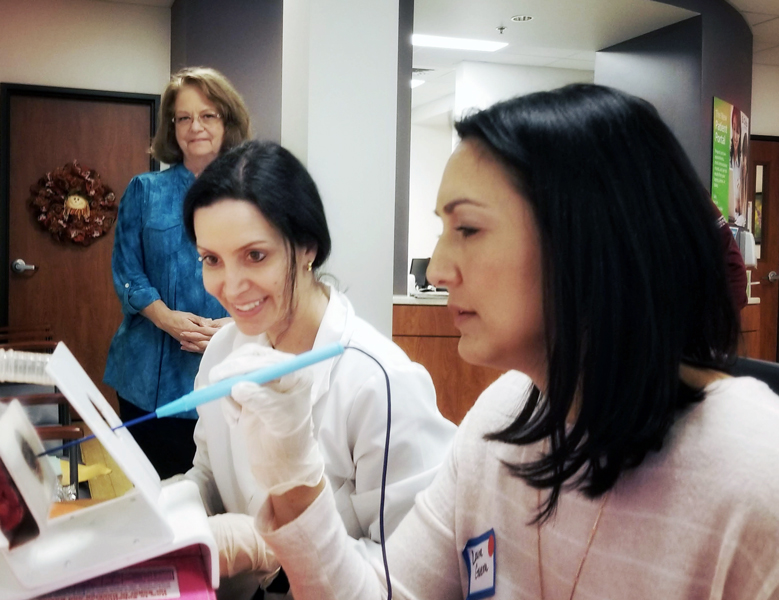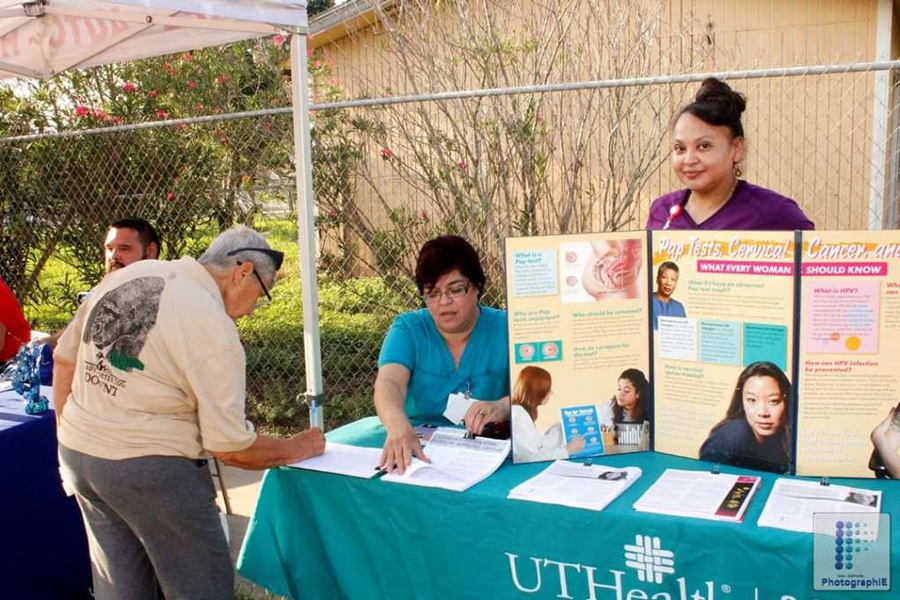Cervical cancer should be one of modern medicine’s success stories — after all, with proper prevention and screening the disease is easy to stop before it starts. And indeed, routine Pap tests and increasingly widespread vaccination against the human papilloma virus (HPV), the leading cause of cervical cancer, have cut its incidence to the point where it is receding as a public health threat in a few countries around the world.
But the story is less rosy for others — such as Hispanics living in the United States, one of the world’s richest nations. They are 35 percent more likely than non-Hispanic whites to be diagnosed with cervical cancer and 24 percent more likely to be killed by it. “What really, really hurts my heart is to see young women dying from this disease,” says Ana M. Rodriguez, an obstetrician and gynecologist who practices at the University of Texas Medical Branch at Galveston. “It is a preventable disease.”
Clinicians working to understand this anomaly say that no single factor is responsible. Language barriers and cultural differences — which complicate education and screening — undoubtedly play a role. Biology might also work against Hispanics. In one study, researchers found that Hispanic women were more likely to be infected by HPV genotypes not covered by existing vaccines (42% versus 24% for non-Hispanic white women). Genetic differences in Hispanic women probably also contribute to increased risk, as might differences in vaginal microbiomes, a factor Rodriguez is currently investigating.
But above all else, researchers and clinicians argue, these disparities reflect the kinds of socioeconomic and health-care-access challenges that Hispanics are more likely to face. The good news is that researchers are beginning to identify ways to surmount these barriers.
Factors that undercut prevention
Cervical cancer is one of the most preventable of all cancers because it emerges slowly, offering many opportunities to thwart worrisome pre-cancerous cells. Because most cervical cancers are caused by sexual transmission of HPV, the most effective protection is for adolescents to get the HPV vaccine before becoming sexually active. Full immunity requires two or three doses of the vaccine, which also protects against other HPV-linked malignancies, including oral and penile cancers.
Guidelines also recommend regular screening for HPV infection, as well as Pap tests. (How often and in what combination depends upon a woman’s age.) Pap screening, which collects and studies cells from the cervix, is designed to look for abnormal cells before they become cancerous. If there are any worrisome findings, the woman might need to return for biopsies or other procedures to remove the abnormal cells.

Illustration of the structure of the human papilloma virus.
CREDIT: STUDIOMOLEKUUL / SHUTTERSTOCK
However, several socioeconomic factors can make Hispanics less likely to take advantage of these preventive measures. For example, individuals who speak less English or have recently moved to the United States understand less about cervical cancer prevention than more acculturated residents, according to studies by Deanna Kepka, a population scientist and an investigator at the University of Utah’s Huntsman Cancer Institute who studies cervical cancer prevention in US Hispanics. Among the gaps: They might not know that HPV causes cervical cancer or that more than one vaccine dose is needed to maximize protection.
Given the connection between HPV and sexual activity, some health providers are already skittish about raising vaccination with parents of adolescents or with young adult patients, Kepka says. “And then you take the language barriers or the cultural barriers and they’re even more hesitant and even less likely to communicate about it.”
Cultural differences also can inhibit women from seeking preventive care. Broadly speaking, the Anglo-European perspective is more rooted in a sense of self-actualization and autonomy over one’s life and health care decisions, says Deborah Parra-Medina, a public health researcher who directs the Latino Research Institute at the University of Texas at Austin.
Parra-Medina, who coauthored a 2009 Annual Review of Public Health paper looking at effective health communication strategies in the Hispanic community, adds that studies have shown that Hispanics are apt to prioritize family needs over those of the individual. “It’s more collectivist, right? So you sacrifice the self for the greater good.” Therefore an approach for clinicians, she suggests, would be to say: “It’s OK for you to put yourself first and your health first. Because you need to be healthy, so that you can be there for your family.”
These 2015 data from the National Health Interview Survey show national US statistics on screening for several malignancies, including cervical cancer, for Hispanics and non-Hispanic whites, insured and uninsured. Although rates are generally lower for Hispanics as a class, rates for uninsured whites may be even lower than those of uninsured Hispanics in some cases.
But even when women want to seek out preventive care, socioeconomic hurdles can make that more difficult for Hispanics, says Kevin Fiscella, a family medicine physician at the University of Rochester Medical Center in New York, who explores factors driving racial and ethnic health disparities in the 2016 Annual Review of Public Health. Although the Affordable Care Act reduced the number of uninsured Americans, Hispanics continue to be the ethnic group most likely to lack coverage, Fiscella points out. And figuring out how to pay the bill for multiple clinic visits isn’t the only financial stress. “There often may be higher opportunity costs,” he says. “If you’re working and struggling to make it, it’s even more costly to take time off.”
A campaign on the border
Rodriguez, who flew to Texas’s Rio Grande Valley at least once a month for seven years through 2018 to run a cervical cancer treatment clinic, can attest that migrant and other temporary work makes for a frequently shifting patient population. Patients’ phone numbers might change. So might where they live, and letters from the clinic urging tests or follow-up might not reach them. “Even if they had very abnormal cervical biopsies that needed to be taken care of immediately,” Rodriguez says, “we had a hard time locating these patients again.”
A paper looking at cervical cancer screening challenges in a broader, seven-county Texas border region from Brownsville to Laredo found that cervical cancer diagnoses run 25 percent higher than statewide rates and 55 percent higher than the national rate. To tackle the problem, Rodriguez is participating in several research initiatives, funded through state grants, that have promoted HPV vaccination and have trained additional clinicians to remove the abnormal cells.
In one of the grant-funded projects, which lasted more than four years and wrapped up its first phase in late 2018, Texas researchers used a public education campaign to enable slightly more than 19,000 Rio Grande Valley women to get cervical cancer screening. Outreach relied in part on community health workers called promotoras to spread the word. A handful of South Texas clinicians were trained to perform a colposcopy — a close examination of the cervix and genital area, possibly followed by biopsy of abnormal cells — and one physician was taught a procedure called LEEP (loop electrosurgical excision procedure) to remove lesions. For years, Rodriguez says, she was the only physician regularly performing these LEEP procedures on uninsured and other underserved women in the valley.

In the Rio Grande Valley, a nurse practitioner (right) is trained by a physician to perform a technique called the loop electrosurgical excision procedure (LEEP), which is used to remove abnormal cervical cancer cells.
CREDIT: COURTESY OF THE UNIVERSITY OF TEXAS MD ANDERSON CANCER CENTER
Training a second physician in the LEEP procedure meant clinicians in the area could remove abnormal cells in women who might not otherwise have been able to get the procedure locally and couldn’t afford to travel elsewhere, says Kathleen Schmeler, a gynecologic oncologist at Houston’s MD Anderson Cancer Center and principal investigator on that project.
“The real question is, what was happening to these patients before, right?” she says. After they got abnormal Pap smear results, “probably nothing. And they’re the ones that see me 5 or 10 years later in Houston with cancer, if they’re lucky enough to get to Houston or somewhere else” for cancer treatment.
Promotoras promote success
The promotoras, local residents hired as community health workers, have been vital to spreading the word about cervical cancer prevention at grocery stores, flea markets and other gathering spots, Rodriguez says.
Similarly, in another Texas-based research project that Parra-Medina was involved with, promotoras increased the likelihood that adolescent girls would complete the full vaccine regimen, by assisting with making appointments and other logistics. Nearly three-fourths of those with support from promotoras completed all three doses, compared to 42.5 percent who were given an educational brochure, according to the study’s findings.
This is in line with other research: A 2015 review of studies examining ways to boost cervical cancer screening among Hispanics concluded that the use of promotoras for community outreach was one of the more promising strategies. Lay health workers played at least some role in 24 of the 32 interventions studied in that review. Some were cancer survivors; others were church members or otherwise representative of the local residents who health workers aimed to make more aware of cervical cancer screening.

Promotoras Jill Morales (right) and Monica Gasca (left) conduct health outreach at an event in Los Indios, Texas, in the Lower Rio Grande Valley.
CREDIT: COURTESY OF THE UNIVERSITY OF TEXAS MD ANDERSON CANCER CENTER
Beyond speaking Spanish, promotoras might be more trusted than clinicians to answer sensitive questions and address misconceptions, Rodriguez says. For instance, some women in the Rio Grande Valley worry that biopsies and other procedures might sabotage their sex lives or their ability to get pregnant, she says.
Rising vaccination rates
There are encouraging signs that younger Hispanic generations might be more protected. As of 2016, 55 percent of Hispanic girls and 46 percent of Hispanic boys had completed the full HPV vaccine regimen; among non-Hispanic whites, 46 percent of girls and 35 percent of boys were similarly protected. That’s encouraging, Kepka says, not just for cervical cancer prevention but also for preventing penile cancer, another malignancy that disproportionately affects Hispanics.
Why the higher vaccination rates in these younger groups? Kepka suggests that since Hispanics are more likely to be uninsured, they rely more on getting care at federally qualified community health centers, public health departments and other safety-net clinics. Those sites might be more apt to routinely provide the HPV vaccine as part of a bundle of vaccines recommended for adolescents at ages 11 and 12.
For lower-income individuals and others who have difficulty getting to medical offices, and who may never have gotten vaccinated, Kepka hopes that one day there will be an alternative: home-based HPV testing, similar to collecting stool samples at home for colon cancer screening. Research has shown that women are able and willing to collect vaginal samples for HPV testing themselves. That could definitely boost access, Kepka says, especially for women who can’t take time off from work to go for well-woman visits. They could visit a doctor if results were abnormal, although some would still need help accessing appointments for follow-up care, including monitoring and biopsies, especially if they are uninsured.
More routine coverage for such follow-up procedures, along with continued vaccine acceptance by adolescent Hispanics, could move the US closer to the public health progress achieved by a few countries such as Australia, experts in health disparities say. Researchers there recently reported that routine screening and vaccination has put that nation on track to reduce cervical cancers to levels no longer deemed a public health threat. But compared with that notable success, Kepka says, “we’ve got a long ways to go.”




